Podcast
Questions and Answers
A car is traveling at a constant velocity. According to Newton's first law, what external factor is required to change the car's velocity?
A car is traveling at a constant velocity. According to Newton's first law, what external factor is required to change the car's velocity?
- Inertia of teh car
- The car's momentum
- Unbalanced force (correct)
- Constant engine force
A force of 20 N is applied to an object with a mass of 5 kg. What is the acceleration of the object according to Newton's second law?
A force of 20 N is applied to an object with a mass of 5 kg. What is the acceleration of the object according to Newton's second law?
- 100 m/s^2
- 2.5 m/s^2
- 0.25 m/s^2
- 4 m/s^2 (correct)
A book rests on a table. Which statement best describes the forces acting according to Newton's third law?
A book rests on a table. Which statement best describes the forces acting according to Newton's third law?
- There are no forces acting since the book is at rest.
- The book exerts a downward force on the table, and the table exerts an equal and opposite force on the book. (correct)
- The book's weight is the only force acting on it.
- The table exerts an upward force on the book, equal to the book's weight.
In a closed system, 500 J of heat is added, and the system performs 200 J of work. According to the First Law of Thermodynamics, what is the change in the internal energy of the system?
In a closed system, 500 J of heat is added, and the system performs 200 J of work. According to the First Law of Thermodynamics, what is the change in the internal energy of the system?
Which of the following scenarios violates the Second Law of Thermodynamics?
Which of the following scenarios violates the Second Law of Thermodynamics?
What does the Zeroth Law of Thermodynamics define?
What does the Zeroth Law of Thermodynamics define?
How would you describe the relationship described by Maxwell's Equations?
How would you describe the relationship described by Maxwell's Equations?
Which phenomenon demonstrates the interaction between electric and magnetic fields?
Which phenomenon demonstrates the interaction between electric and magnetic fields?
What is one of the ways that light can be described?
What is one of the ways that light can be described?
How are electric fields produced, as described by electromagnetism?
How are electric fields produced, as described by electromagnetism?
How does general relativity refine our understanding of gravity compared to Newtonian gravity?
How does general relativity refine our understanding of gravity compared to Newtonian gravity?
Which of the following scenarios necessitate the application of quantum mechanics over classical mechanics?
Which of the following scenarios necessitate the application of quantum mechanics over classical mechanics?
What is a key implication of the constancy of the speed of light in all inertial frames, as described by special relativity?
What is a key implication of the constancy of the speed of light in all inertial frames, as described by special relativity?
How do reflection, refraction, and diffraction relate to the function of lenses and mirrors?
How do reflection, refraction, and diffraction relate to the function of lenses and mirrors?
Why is the equation $E=mc^2$ significant in the context of special relativity?
Why is the equation $E=mc^2$ significant in the context of special relativity?
What is the primary focus of atomic physics, and how does it differ from nuclear physics?
What is the primary focus of atomic physics, and how does it differ from nuclear physics?
How do advancements in understanding the behavior of light contribute to modern technology?
How do advancements in understanding the behavior of light contribute to modern technology?
What is a central concept in quantum mechanics that distinguishes it from classical mechanics?
What is a central concept in quantum mechanics that distinguishes it from classical mechanics?
Why is the ongoing effort to create a unified theory in modern physics considered significant?
Why is the ongoing effort to create a unified theory in modern physics considered significant?
Which areas of modern technology directly rely on the principles of quantum mechanics?
Which areas of modern technology directly rely on the principles of quantum mechanics?
Flashcards
Newton's First Law
Newton's First Law
An object remains at rest or in uniform motion unless acted upon by an unbalanced force.
Newton's Second Law
Newton's Second Law
The acceleration of an object is proportional to the net force and inversely proportional to its mass (F = ma).
Newton's Third Law
Newton's Third Law
For every action, there is an equal and opposite reaction.
Inertia
Inertia
Signup and view all the flashcards
Thermal Equilibrium
Thermal Equilibrium
Signup and view all the flashcards
First Law of Thermodynamics
First Law of Thermodynamics
Signup and view all the flashcards
Entropy
Entropy
Signup and view all the flashcards
Maxwell's Equations
Maxwell's Equations
Signup and view all the flashcards
Electromagnetic Waves
Electromagnetic Waves
Signup and view all the flashcards
Optics
Optics
Signup and view all the flashcards
Lenses and Mirrors
Lenses and Mirrors
Signup and view all the flashcards
Wave-Particle Duality
Wave-Particle Duality
Signup and view all the flashcards
Quantum Mechanics
Quantum Mechanics
Signup and view all the flashcards
Time Dilation
Time Dilation
Signup and view all the flashcards
Length Contraction
Length Contraction
Signup and view all the flashcards
E=mc²
E=mc²
Signup and view all the flashcards
General Relativity
General Relativity
Signup and view all the flashcards
Atomic Physics
Atomic Physics
Signup and view all the flashcards
Nuclear Physics
Nuclear Physics
Signup and view all the flashcards
Study Notes
Classical Mechanics
- Classical mechanics describes the motion of macroscopic objects.
- It relies on Newton's laws of motion.
- Newton's first law states that an object at rest stays at rest and an object in motion stays in motion with the same speed and in the same direction unless acted upon by an unbalanced force.
- Newton's second law states that the acceleration of an object is directly proportional to the net force acting on it and inversely proportional to its mass. (F = ma)
- Newton's third law states that for every action, there is an equal and opposite reaction.
- Concepts like inertia, momentum, and energy are fundamental to classical mechanics.
- Classical mechanics is highly applicable to everyday phenomena and engineering designs.
- It can be used to predict the trajectories of projectiles, the motion of planets, and other objects.
Thermodynamics
- Thermodynamics deals with heat, work, and energy transfer.
- It describes how thermal energy is related to other forms of energy.
- The Zeroth Law of Thermodynamics defines thermal equilibrium.
- The First Law of Thermodynamics states that energy cannot be created or destroyed, only transferred or changed from one form to another. (ΔU = Q - W) where ΔU is change in internal energy, Q is heat added, and W is work done.
- The Second Law of Thermodynamics states that the total entropy of an isolated system can only increase over time.
- The Third Law of Thermodynamics states that the entropy of a perfect crystal at absolute zero temperature is zero.
- Thermodynamics finds applications in various fields, including power generation, refrigeration, and chemical processes, among others.
Electromagnetism
- Electromagnetism describes the interaction between electric charges and magnetic fields.
- Fundamental concepts include electric fields and forces, magnetic fields and forces.
- Electric charges produce electric fields. Moving charges produce magnetic fields.
- Electromagnetic forces are very strong and play a crucial role in various phenomena.
- The relationship between electric and magnetic fields is described by Maxwell's equations.
- Maxwell's equations unify electricity, magnetism, and light.
- Electromagnetic waves, such as light, are a consequence of these interactions, and these waves propagate through space at a defined speed.
Optics
- Optics studies the behavior of light as it propagates, interacts with matter, and is detected.
- Light can be described as a wave or a particle (photons).
- Reflection, refraction, diffraction, and interference are key concepts in optics.
- Lenses and mirrors are used to manipulate light and create images.
- The behavior of light is crucial in many technologies such as cameras, telescopes, and fiber optics. Understanding how light behaves allows advancements in many technological sectors.
Quantum Mechanics
- Quantum mechanics describes the physical properties of nature at the scale of atoms and subatomic particles.
- It departs significantly from classical mechanics at this level.
- Key concepts include quantized energy levels, wave-particle duality, and uncertainty principles.
- The behavior of matter at the quantum level is highly probabilistic.
- Quantum mechanics has numerous applications, including transistors, lasers, and medical imaging.
- Examples include understanding the behavior of atoms and molecules, and their properties.
- It's necessary to consider the discrete nature of energy in certain physical phenomena, like atomic transitions.
- Quantum mechanics provides a fundamental framework for understanding and describing the microscopic world, and much of modern technology relies on its principles.
Relativity
- Special relativity describes the relationship between space and time for observers in uniform motion.
- It posits the constancy of the speed of light in all inertial frames.
- This leads to consequences such as time dilation and length contraction.
- Special relativity also deals with the equivalence of mass and energy (E=mc²).
- General relativity extends special relativity to include accelerating observers and gravity.
- It describes gravity as a curvature of spacetime caused by mass and energy.
- General relativity provides a more accurate description of gravity than Newtonian gravity, especially in extreme conditions. It has profound implications for cosmology and astrophysics.
Modern Physics
- Modern physics encompasses relativistic physics and quantum mechanics.
- These theories revolutionized our understanding of the universe at both the very large and very small scales.
- Combining relativity and quantum mechanics is a still-developing area of physics. There are ongoing efforts to create a unified theory of all fundamental forces.
Atomic and Nuclear Physics
- Atomic physics examines the structure and behavior of atoms.
- It involves principles of both classical and quantum mechanics.
- Nuclear physics deals with the structure and properties of atomic nuclei and the interactions between them.
- Radioactive decay, nuclear reactions, and nuclear power are areas of interest in nuclear physics.
- These fields have significant applications in medicine, energy production, and scientific research.
Studying That Suits You
Use AI to generate personalized quizzes and flashcards to suit your learning preferences.




